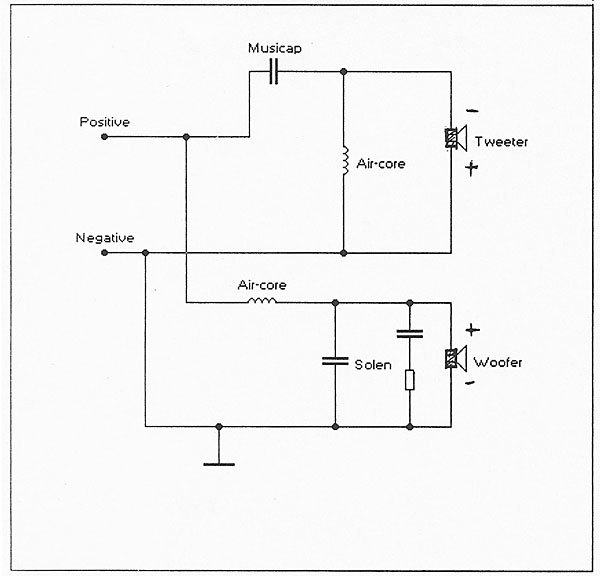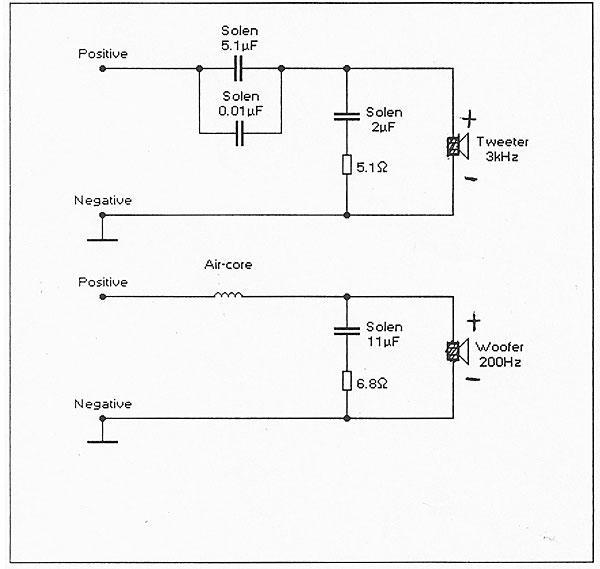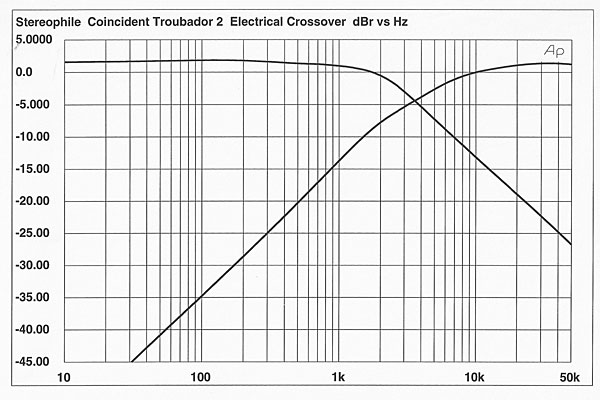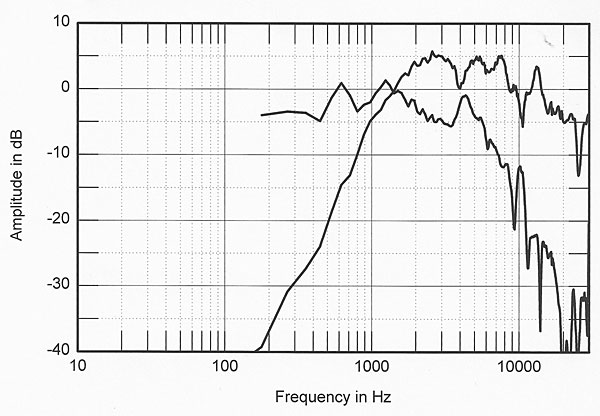| Columns Retired Columns & Blogs |
What's going on here?
Following publicaiton of the "Follow-Up" review of the Troubador, I performed a further set of measurements, as well as looking at the crossovers of both examples. Fig.7 shows the circuit diagram of the crossover for the first (rosewood) pair of Troubadors. No values are marked on this diagram as they had all been painted over on the components. Other than a Zobel, series-RC network connected in parallel with the woofer terminals, this appears to be an absolutely conventional parallel second-order design. As is usual with such a topology, the tweeter is connected with inverted electrical polarity compared with the woofer. With a conventional non-coincident design, this, in conjunction with the high- and low-pass phase shifts through the crossover region, gives the optimal, most flat response. In the first sample of the Troubador, however, a very audible and large suckout appears in the crossover region with this electrical connection. This, I assume, is due to the time delay between the acoustic centers of the woofer and tweeter interfering with the drive-units' relative phase responses.

As Israel Blume mentioned in his "Manufacturer's Comment" letter in the January issue of Stereophile (p.335), the second (gray) sample of the Troubador has a first-order crossover with the tweeter and woofer connected with the same electrical polarity. Fig.8 shows the circuit diagram I traced out for one of these samples. Each drive-unit has a Zobel network connected in parallel with its terminals.

Fig.9 shows the revised Troubador's crossover electrical drive signals, measured at the drive-unit terminals. The electrical crossover point is set to 3.5kHz, with first-order, 6dB/octave, electrical high- and low-pass slopes. But it is incorrect to equate those electrical slopes with the ultimate acoustic crossover slopes, which is what I measured in my February review and showed as my fig.3.

Fig.10 shows the on-axis acoustic responses of the two sections of the Troubador's concentric drive-unit, obtained by attaching the cable from the amplifier directly to the loudspeaker drive-unit electrical terminals. The series crossover components are therefore not in-circuit for these measurements. The Zobel networks are in-circuit, but they do not materially affect the results.

First, even without a crossover, the tweeter rolls off smoothly with an approximate second-order, 12dB/octave, high-pass acoustic slope below 2.4kHz. This will add to the electrical high-pass slope to give an overall third-order, 18dB/octave acoustic slope, just as I described in the February 1996 issue of Stereophile (p.185). Second, the woofer also starts to roll out above 1.5kHz, though its natural low-pass slope is far from smooth, being broken up by peaks and dips. Its average acoustic slope, however, is 13.3dB/octave between 4.35kHz and 17.4kHz. just slightly greater than second-order. Again, when the electrical low-pass slope is added to this acoustic slope, the ultimate crossover slope is approximately 19dB/octave, basically third-order, just as I described in my Follow-Up review.
A designer using this concentric two-way drive-unit and first-order electrical high- and low-pass filters will therefore produce what appears to be a third-order acoustic crossover. To produce an acoustic first-order crossover, as used in Thiel designs, takes a more thorough view of system design, in my opinion.
With a conventional, spaced-driver speaker design, use of a first-order electrical crossover and drive-units connected in the same electrical polarity should give a flat response through the crossover, as the individual drive-unit responses will add in-phase in this region. However, unless the speaker's baffle is sloped back, the optimal listening axis will be well below the tweeter, due to the different listener distances to the acoustic centers of the two drive-units. With a flat baffle, the acoustic center of the tweeter is closer to the listener than the acoustic center of the woofer.
In the case of the second sample of the Troubador, the concentric twin drive-unit appears to place the acoustic center of the tweeter in a different position from that of the woofer. The resultant time delay between the two driver outputs gives a relative phase shift between the tweeter and woofer sufficient to cause cancellation in the region where the outputs of the two drivers overlap, exactly as I showed in my February Follow-Up. This cancellation is why I found the second sample of the Troubador to sound both rather hollow and somewhat uninvolving.
If you invert the tweeter's electrical polarity, you almost exactly compensate for this time-delay-caused phase shift. As a result, the tweeter and woofer outputs now add in-phase in the crossover region, again as I showed in my Follow-Up. However, if you look back at fig.4 in the review, you can see that for an identical electrical drive signal, the Troubador's tweeter gives an acoustic output approximately 5dB too high in level compared with that of the woofer. This is why I found the sound of the second Troubador sample too "shouty" in the treble with inverted tweeter polarity. This, I believe, is why Coincident now offers a resistor L-pad kit to bring the tweeter's sensitivity more in line with that of the woofer when the tweeter is connected with inverted polarity.—John Atkinson

What's going on here?

It's the token bad review that Stereophile feels it has to throw out to remind readers that on exceedingly rare occasions, it actually does take a break from the non stop advertising/promotional campaigns which help keep the lights on and pay for airfares for "journalists" to travel from show to show in which they endlessly kibitz with other "industry" figures in dining rooms and bars across the United States....lol!
[Possibly actionable defamation deleted by JA]
Now if only we could get these "journalists" to stop giving "very highly recommended" review summaries for products like a $6000 tube amp whose volume control gets too hot to touch... (eyeroll)
[More defamatory content deleted. If you continue to post defamatory and personal comments, we will have no option but to ban you from this site, mrplankton2u.-JA]

I don't think you have a clue what the term "defamatory" actually means so I've cited a definition below:
"Defamation—also called calumny, vilification, traducement, slander (for transitory statements), and libel (for written, broadcast, or otherwise published words)—is the communication of a statement that makes a claim, expressly stated or implied to be factual, that may give an individual, business, product, group, government, religion, or nation a negative or inferior image. This can be also any disparaging statement made by one person about another, which is communicated or published, whether true or false, depending on legal state. In Common Law it is usually a requirement that this claim be false and that the publication is communicated to someone other than the person defamed (theclaimant).[1]"
Note, Mr. Atkinson, that under "common law", the requirement for defamation is that published claims are false. [Edited by John Atkinson]

It is pretty obvious that Mr Blume is clueless when it comes to speaker design. Even the "novices" on real audio forums know about the importance of acoustic phase.

Thanks for the honest review.

Well maybe more of a "Don't tell us the truth or you will be banned"attitude. When logic fails, just delete posts and call it "defaming". Lame.

You mean the truth as you see it JohnnyR ?
After reading many of your posts I would say there anything but true.
I'm usually agaist banning anyone, but I'll make an exception in your case. You contribute nothing to this great site and depict yourself as an unhappy and uneducated troll. BEAT IT.

......that MrPlankton2U spelled out what was going on and JA deleted it because? I'm glad you have no say so as to who should be banned. By the way it's "they're" NOT "there". Please be more civil in the future and perhaps you won't be making errors.
Mr Blume obviously didn't bother to measure his finished speaker. I'm betting he used his "golden ears" to judge them. Ahhhhh the folly of relying upon "what he heard".